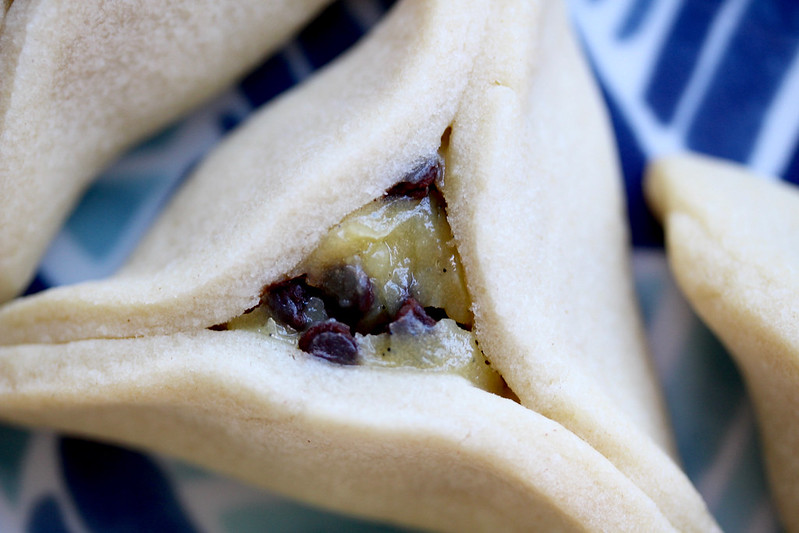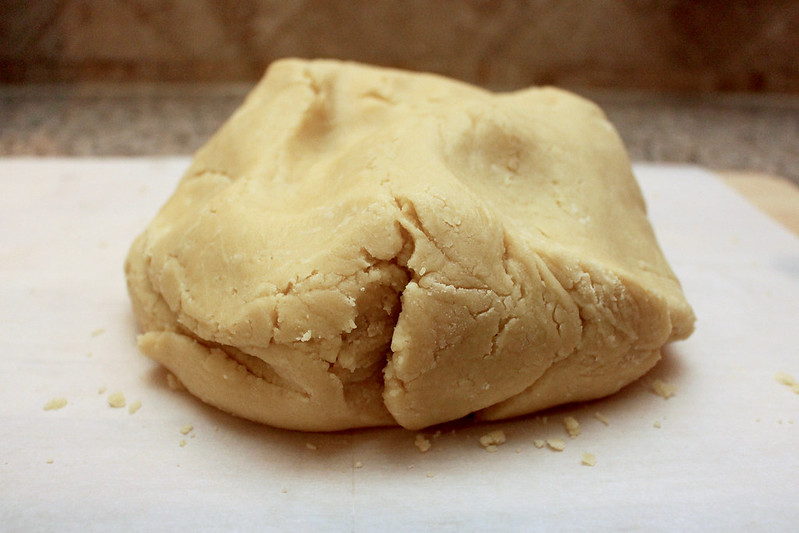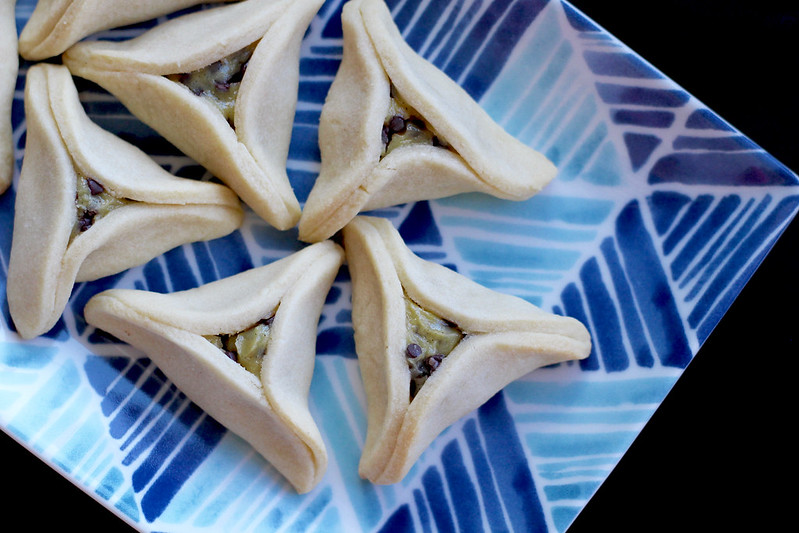
I know, I know– Purim was last weekend. But I’ve had so much fun hamantashening this year that I didn’t have enough time to put together a blog post before the holiday. And then I wondered whether it was worth it to write one up after the fact– I mean, who’s still making hamantashen now? But then I thought about how awesome hamantashen are, and I decided that it’s perfectly fine to keep this hamantashen party going, at least for another week. Who’s in??
For I-don’t-how-many years, I’ve been searching high and low for a good hamantashen dough recipe. You would not think this would be a difficult thing, but I tried quite a few (even from some of my favorite reliable bakeries), but they were either too flaky or didn’t hold their shape or just tasted meh. I was close last year, but still felt like there was room for improvement. But then… THEN! Breads Bakery in New York came out with their cookbook Breaking Breads last Fall, which made me quite literally cry because so many of my favorite Israeli pastries were now in my hands to make. I’d never been in NYC in March to sample their hamantashen first-hand, but if anyone should be the authority on hamantashen, Chef Uri Scheft would be my best guess. So I knew that this Almond Shortbread dough would be the first recipe to try this year, and I’m so thrilled to say that for most hamantashen flavors, I will never need another dough– it is the stuff of hamantashen hopes and dreams! The dough is tender, buttery, and super versatile, paring with a number of filling flavors, both from their book as well as others that I tried from various sources. NAILED IT.
For those new to hamantashen, these are triangle-shaped cookies traditionally filled with poppy seeds or fruit jam that are eaten to celebrate the Jewish holiday of Purim. In recent years, bakers are upping their game by introducing all kids of creative dough and filling flavors. I’ve seen chocolate-peanut butter, funfetti (working on some of these!), cookies and cream, caramel-apple, pecan pie, and even a number of savory choices. (Cheddar Biscuit Hamantashen, anyone?) I pretty much want to shove all of these variations in my pie hole, but I settled for a handful of flavors that would go well with this dough. Some involved simply opening a jar, such as apricot jam and speculoos, whereas some required some advance preparation, such as these Chocolate Chip & Vanilla Cream Hamantashen from Breaking Breads.
The dough is not complicated to make, only slightly more so than any other sugar cookie-type of dough. It does include some almond flour, and while I’m not sure what purpose it serves, it definitely ain’t broke, so I’m going with it. And the best part is, you get to Hulk-smash the cold butter sticks with a rolling pin before they go in the mixer!
A few dough notes:
- I doubled the batch so that I would have enough for a variety of fillings, and also because the recipe calls for 1½ beaten eggs. In order to avoid dividing beaten eggs in half, I simply doubled it to 3 eggs. MORE COOKIES.
- I would recommend using the weight measurements, as these are always more accurate than volume, and I think especially since they certainly use weight at a professional production facility like Breads.
- The instructions say to mix just until combined after adding the eggs, but they don’t really combine fully– I let the mixer run for a little bit because the mixture wasn’t uniform, and I settled for “wet scrambled eggs” as the signal to stop beating. As soon as I added the dry ingredients, the dough came together just fine.
- I rolled the double batch into a half-sheet pan and lopped off slabs for mini batches with different fillings– this worked really well, as I only needed to roll out small amounts at a time.
- The only minor issue I had with the dough was cracking while I shaped the triangles, which tended to happen when the dough was on the colder side. If you find that this happens to your dough, you can shape the hamantashen when the dough is pliable, then chill the assembled cookies before baking (rather than chilling the plain dough circles).
For the vanilla pastry cream, all went according to plan, except that during the second heating phase (after pouring the tempered eggs back into the hot milk), the mixture seemed to curdle unexpectedly. The recipe says to cook the pastry cream over medium heat, but I’d use low or medium-low in the future. Fortunately I was able to stir it smooth (though quite thick), and because this isn’t a fancy pastry cream application, I was still able to use it. Also, I used micro chocolate chips and stirred them right into the pastry cream after it was chilled, instead of just adding them on top– I think mini chips would work well like this too.
I loved this vanilla and chocolate version– never made any hamantashen like these before. They will for sure go into the annual rotation, along with apricot and chocolate.
Chocolate Chip & Vanilla Pastry Cream Hamantashen
Adapted from Breaking Breads by Uri Scheft
Yields 30-40 cookies
This recipe doubles very well if you want to avoid splitting beaten eggs and/or have lots of dough for multiple fillings. There is a lot of leftover pastry cream– yet another reason to make extra dough! I strongly recommend using weight rather than volume to measure ingredients.
For the almond shortbread:
- 400 grams (3 ⅓ cups) all-purpose flour
- 50 grams (½ cup) blanched almond flour
- 1 teaspoon fine salt
- 230 grams (2 sticks/1 cup/8 ounces) cold unsalted butter
- 100 grams (scant 1 cup) confectioners’ sugar
- 50 grams (¼ cup) granulated sugar
- 1½ large eggs, beaten, at room temperature
For the chocolate chip vanilla cream:
- 120 grams egg yolks (from 6-9 eggs), at room temperature
- 125 grams (⅔ cup) granulated sugar
- 45 grams (⅓) cornstarch
- 480 grams (2 cups) whole milk
- 1 tablespoon vanilla bean paste or seeds scraped from 1 vanilla bean pod
- 150 grams (1 cup) micro or mini chocolate chips
To make the almond shortbread dough:
Line a rimmed half-sheet pan with a piece of parchment paper and set aside.
Whisk together the all-purpose flour, almond flour, and salt in a bowl and keep it nearby.
Lay a piece of parchment paper on your work surface and place one stick of butter on top. Smash the butter with a rolling pin several times to soften it, then transfer it to the bowl of a stand mixer fitted with the paddle attachment. Repeat with the remaining stick of butter.
Add the confectioners’ sugar and granulated sugar to the bowl. Mix on low just until the loose sugar is incorporated. Scrape down the bowl and the beater, and mix again for about 30 seconds on medium-low speed. You want the butter to still be cold, and you’re mixing minimally here to avoid aerating the butter.
Pour in the beaten eggs and paddle on low speed until the mixture looks like wet scrambled eggs– the butter chunks should all be coated in egg liberally.
Add the dry ingredients to the bowl (gradually if making a double-batch) and mix on low speed until most of the flour has been incorporated; it’s helpful to stop and scrape down the bowl and beater midway through.
Turn the dough out onto the parchment paper on your work surface and finish mixing it by hand or with a flexible bench scraper to bring it together into one mostly smooth mound. Transfer the dough to the prepared half-sheet pan and flatten it out with your hands or a rolling pin to a thickness of ½-inch. Cover it tightly with a piece of plastic wrap and chill in the refrigerator for at least 2 hours (or until firm), or overnight.
To make the chocolate chip vanilla pastry cream:
If you wish to cool the pastry cream in an ice bath, fill a bowl large bowl partway with ice and cold water; set aside.
Whisk the egg yolks and sugar together in a heatproof medium bowl. Add the cornstarch and whisk until it is completely blended. Keep the bowl next to the stovetop.
Whisk the milk and vanilla in a medium heavy-bottom saucepan over medium heat. Bring it to a simmer, stirring occasionally. Stream a little milk into the egg/sugar mixture, stirring constantly to keep the eggs from scrambling. Gradually stream in more milk until the bottom of the bowl is warm, about ⅓ of the milk; the eggs will be tempered at this point. Pour all of the egg mixture back into the pot with the remaining hot milk and continue to stir.
Stirring the entire time, cook the pastry cream over low or medium-low heat until it has achieved a smooth, thickened texture; steam should rise off the surface and a couple of bubbles start to burst (about 4-6 minutes). If the custard thickens too quickly or starts to curdle, immediately remove the pot from the heat and stir vigorously to smooth it out.
Scrape the pastry cream into a heatproof bowl and nestle it in the bowl of ice water; stir occasionally until the pastry cream is nearly room temperature. Place a piece of plastic wrap directly on the surface and place the bowl in the fridge to chill for at least 2 hours or up to 2 days.
To assemble and bake the hamantashen:
When you’re ready to roll and cut the dough, preheat the oven to 350°F and place a rack in the center position. Line a rimless cookie sheet with parchment paper. Remove the dough from the fridge and let it soften for 5-10 minutes. Remove the pastry cream from the fridge and stir vigorously to loosen it. Fold in the chocolate chips with a rubber spatula.
On a lightly floured work surface, roll the dough out to a thickness of about ⅛”, flouring and moving the dough around as needed to avoid sticking to the work surface and rolling pin. (I didn’t find it to be exceptionally sticky to begin with.) If making a double-batch, cut off pieces of dough as needed with a sharp knife or bench scraper.
Cut out circles with a 3″ round cutter and transfer them to the prepared cookie sheet. Try to cut them out as closely as possible to avoid having a lot of scraps. Re-roll the scraps and repeat until you’ve filled the cookie sheet. If the dough has warmed up and softened too much, place the pan in the freezer for 5 minutes to chill the dough circles. (You can put any warm dough scraps in the freezer for a few minutes to firm up.)
Dollop about ½ teaspoon pastry cream in the center of each circle; a spring-loaded melon-baller yields a perfectly-sized portion. Do not be tempted to put in more filling– the cookies will spill over or open up in the oven.
To create the hamantashen triangle shape, use your fingers to curve up the edges of each circle to meet at three points. Gently press the corners together to seal the edges together, leaving the top open for the filling to peek out. If they crack around the corners or bottom, gently pinch the broken dough back together. Place them on the prepared baking sheet. If the cookies are very soft, put the pan in the fridge for 5 minutes.
Bake the hamantashen for about 14-16 minutes, or until the corners are lightly golden, rotating the pan halfway through. Set the pan on a wire cooling rack to cool completely.
Store the cookies in an airtight container for up to 3 days or so– they won’t last that long.
© Dafna Adler & Stellina Sweets, 2017.





























3 Responses
THANK YOU! I’ve stopped making hamantaschen because they were just so disappointing. Zingerman’s in AA has my all-time favorite – the vanilla filing is TO DIE FOR – and I’ve begged, begged, begged them to give me the recipe (I’m 1000 miles away!) but they won’t. One year they gave me the ingredients, but I couldn’t pull it off. You can buy them here –
https://www.zingermans.com/Product.aspx?ProductID=P-HAM&crf=BAKEHOUSE
Anyway, I’ll try yours!
Aw man! Yeah, it’s really hard to find a good dough recipe when you have a specific flavor/texture in mind. I definitely recommend this one– Breads Bakery is phenomenal. And the dough works with lots of different fillings. Good luck! 🙂